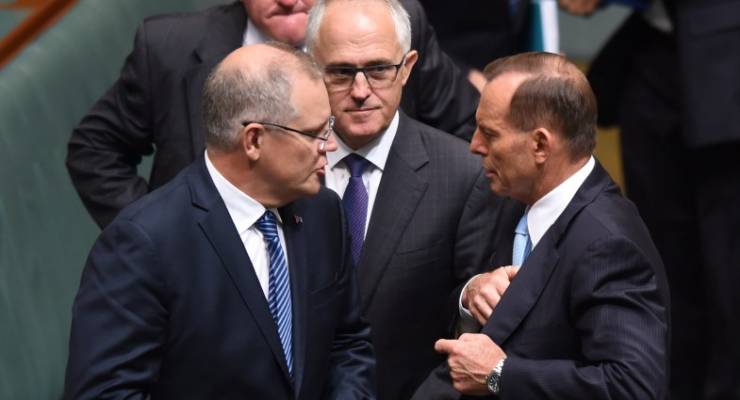
Earlier this week Prime Minister Scott Morrison called a late-night party room meeting to talk about leadership spills. It wasn’t that Morrison had decided to save us all a lot of time by stepping down and letting the cabinet fight, Death of Stalin style, for his suddenly vacant seat — quite the opposite. The rule changes shore up his position, by making it harder to knife a sitting prime minister.
So, given this happens so often, it’s worth examining the rules. How do the major parties decide on who will lead them?
Liberal
Morrison’s new threshold to trigger a Liberal leadership change (in government) requires two-thirds of the partyroom vote. The new rules only apply to sitting prime ministers — they don’t apply when the Liberals are in opposition. They came about following consultation with former prime ministers John Howard and Tony Abbott, but not Malcolm Turnbull.
Morrison’s move is a classic one, as you consider he in fact benefited from a knifing. He’s effectively made sure the process that made him prime minister can never happen again. If the Liberal Party had these rules in August, Turnbull — who held out until 44 people agreed to sign a petition to oust him — would not have been rolled. Previously, just one senator or MP could call a spill, and if the motion was seconded it was then put to Liberal Party MPs, where it needed a majority plus one.
Labor
Kevin Rudd, never one to do things by halves, managed to be both a knifer and a knifee. When he assumed the office of PM for the second time, he put in place rules that would have:
a) Not allowed him to ascend to the leadership in 2006, when he challenged Kim Beazley
b) Not have saved him when the bell tolled in 2010 and Julia Gillard took over
c) Would not have gotten him the PMship back in 2013 when he took his revenge.
Now, knocking off a leader requires a minimum of 60% of the caucus vote if the party is in opposition, and 75% if it is in government. Previously it fell to just the parliamentary wing of the party.
Greens
Prior to 2005, the Greens thought a formal leader was for narcs, man, but as their numbers and influence grew in Parliament, the party firmed up its structure and elected senator Bob Brown as federal leader. At the moment, Greens leaders are decided by Greens MPs, though so far it’s been moot, given all three of their leaders have been elected unopposed.
Recently, there have been pushes for members to directly elect the federal parliamentary leader. This has been pushed by Brisbane councillor, resignation hijacker and “man you could tell did slam poetry before you saw him do slam poetry” Jonathan Sri.
The Nationals
Nationals leader and, therefore, our Deputy PM, Michael McCormack is best suited to running unopposed (he tends to come second if that’s an option). In the event that more than one person shows up, it’s the Nats MPs who select the leader and deputy leader.
Pauline Hanson’s One Nation
Since her return to parliament, Hanson has proven she really is the true Aussie battler’s despot by rewriting the party’s constitution to make her president for life. She’s also the senior executive officer, the head of the national executive, and the registered officer of all One Nation divisions.








We can only be thankful that the new rule that Morrison doesn’t apply to himself, and even more importantly, didn’t apply to the Mad Monk. Imagine years more of that throwback a the helm….. doesn’t bear thinking about. So it’ll be interesting to see what/who they throw up next to lead them into the wilderness.
“throw up” being the perfect description of what they produce.
Abbott would not have been overthrown in September 2015 (Turnbull managed 55%, not 60% of the party room), and so would have lead the party in the 2016 election – but to what outcome?
I hear he’s leading them into the wilderness because he is ashamed to be seen in town with them.
That is amazing!
I thought the powerbrokers just went out into the forest and shook a likely looking tree.
The first to fall out is obviously a slippery bastard, so he becomes Prime Minister.
Keep shaking until the required number, less one, is collected.
Finally give the tree a really hard shake. the last to fall clearly has a good grasp of things, so that one becomes Chief Whip.
Let’s see how this pans out. How long can a leader hold on with a solid 60% against them ? Once you fall below 60% support you’re in trouble let alone 60 against.
Wonderful pic of the Three unAmigos – who is the hulk in the background?
… ahh, more of his mug in the pic above the comments, the man with a voice like 40 miles of bad road. McLachlan?
It seems quite extraordinary that anyone actually believes these rules change anything in substance.
Does anyone actually believe a leader could remain in place if 60% of the party room voted against him/her?
On top of that, how does anyone actually believe that the prospect of Morrison being unremovable in the scary event that he wins the election actually improves the Coalition’s appeal???
Labor can campaign that “a vote for the Liberals is a vote for Scott Morrison.” Scary…